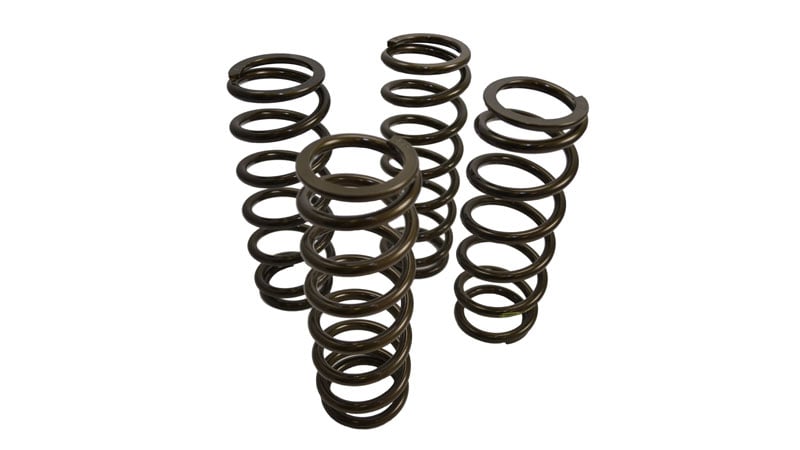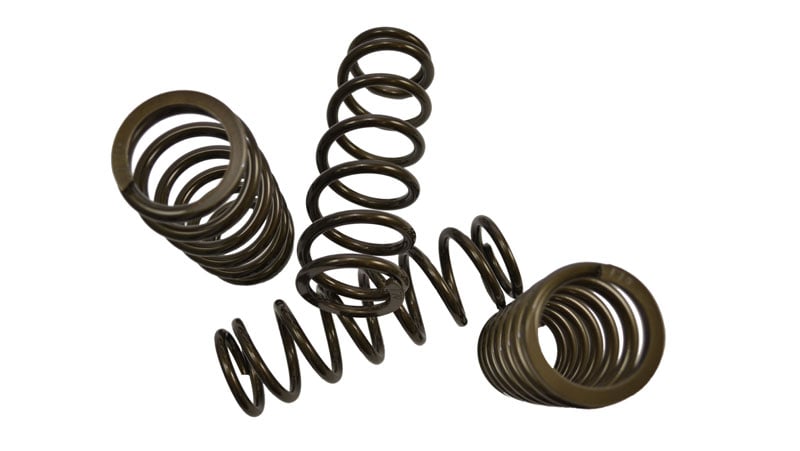Introduction
Ninety percent of the performance and feel of your suspension comes from having the proper spring and shock combination. But what contributes to the perfect combo? There’s no one-size-fits-all solution, as drivers have varying needs and expectations, and there’s a lot to consider. That’s why it’s critical to understand the relationship between your suspension system and shocks and springs. Because whether you’re driving a dirt late model car, motorcycle, truck, or mountain bike, without the right combination, it can get bumpy, expensive, and potentially dangerous.
Shocks, Springs, and Your Suspension System
Your suspension system consists of a number of different components, but the most important pieces are springs, shocks, and tires. When these components are working together, drivers can easily maintain control over their vehicles. However, when drivers either don’t have the correct components in place or attempt to use their vehicle in a way that the current suspension system does not support, you’re going to have problems.
The correct suspension for any vehicle is important because roads are susceptible to hazards, including potholes, loose gravel, branches, and much more, putting unprepared drivers at risk. In areas prone to extreme weather, there can be even more challenges on the road. When you consider additional needs to adjust the suspension, such as in competitive drag racing with a car or a motorcycle, the suspension becomes even more complicated. However, with the right setup, drivers can find the right balance for them and gain a significant competitive edge from the proper suspension behavior.
The Odd Couple or Match Made in Heaven?
Springs are one of the most crucial parts of your suspension setup. They determine how close or far your chassis sits from the road or track. Adjusting the springs helps prevent bottoming out, limiting body roll when accelerating and cornering, and limiting nose-diving when braking. They are essential in determining how your car handles. The shocks (dampers) help to manage and restrict the motion of the springs, absorbing the impact on their behalf. This means that springs that are too stiff, for example, may not be the best for drivers looking to handle their car in bumpy conditions.
By learning how shocks and springs work together, drivers and riders can better understand their unique needs and begin to experiment and adjust to get the ideal suspension for a competitive edge. The correct suspension can also serve drivers who love to get off the road and out on the trail, helping them to access better courses and maintain the durability of their bike, Jeep or SUV. At the very least, the right suspension and regular maintenance of your vehicle contribute to a smoother ride and help to avoid unnecessary expenses. A suspension that is not working properly can cause parts to wear out prematurely and require replacement. Wearable items like bushings and tires can all wear much quicker on vehicles where the suspension is not working properly.
In this piece, we will be covering:
- The evolution of the spring
- How to focus on both proper spring rate and damping
- Advances in spring technology, both conventional and air springs
- Different areas of damping and how they can control the spring rate
- Different areas of damping that directly affect mechanical grip, chassis stability, braking, and other key suspension characteristics
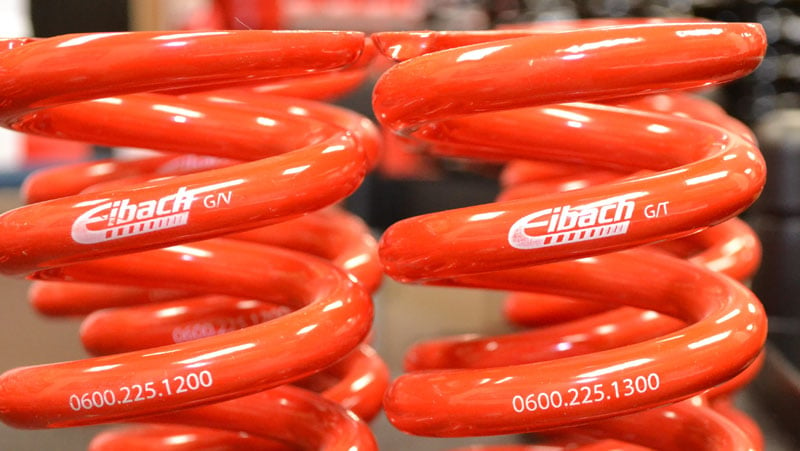
Spring Technology - Evolution of the Spring
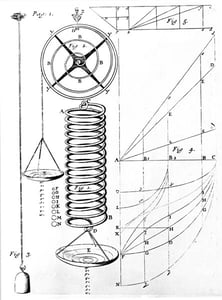 The springs, in some form, have likely been used for thousands of years in vehicles and even devices such as the bow and arrow. Thanks to the research of a philosopher named Robert Hooke and “Hooke’s Law,” the world would eventually learn that when stress applied to a body goes beyond a certain value (the elastic limit), once the stress is removed, the body does not return to its original state. This eventually contributed to the invention of the first coiled spring in 1763 by R. Tradwell.
The springs, in some form, have likely been used for thousands of years in vehicles and even devices such as the bow and arrow. Thanks to the research of a philosopher named Robert Hooke and “Hooke’s Law,” the world would eventually learn that when stress applied to a body goes beyond a certain value (the elastic limit), once the stress is removed, the body does not return to its original state. This eventually contributed to the invention of the first coiled spring in 1763 by R. Tradwell.
Since then, the basic design of the spring has changed, as well as the materials used to create a spring. The modern spring is essential to the suspension system, as springs store mechanical energy and support the weight of the vehicle.
In addition to having springs made from alternative materials such as carbon, air, and other designs, the different types of springs that you find in vehicles include:
- Conventional Coil Springs
- Leaf Spring
- Stacked Spring Combinations
- Dual or Triple Rate (stack spring combinations)
- Air Springs
- Bump Stops
Here are a few examples of spring designs and where and how they are currently used, as well as some advantages and disadvantages of each.
FREE DOWNLOAD - Damper Tuning Guide (Starter)
Ensuring a well-tuned damper setup can translate to significant performance gains on track. If you are unsure of where to begin the tuning process, this is a great starting point. Maximize the results of your shock adjustments with our free damper tuning guide download.
Leaf Springs
Leaf Springs, an early design of springs, were initially just stacked metal that was bent to produce a spring rate. In the Roman era, leaf springs were used in chariots and, eventually, in the early vehicles that came off assembly lines. Still today, some manufacturers use this spring technology to support commercial vans, trucks, trailers, and other vehicles. There are also a variety of types of leaf springs, such as elliptical leaf springs, semi-elliptical, three-quarter elliptical, quarter leaf, and more.
Typically, fitment can be a big reason to use this design. If you look at a coil spring vs. a leaf spring, you will notice the leaf spring is a much flatter design that doesn’t take up much space vertically. This can be an advantage when designing and space is limited. They can also provide more support to larger vehicles.
However, there are disadvantages to leaf springs. They don’t provide a lot of flexibility and can be challenging to make changes to. For drivers who want to experiment with different suspension setups, leaf springs may not be the best match. Additionally, there can be a lot of friction between each leaf, and in time, leaf springs can lose their shape. Traditional springs, such as coil springs, may last longer, depending on the circumstances.
Coil Springs
Coil springs are round pieces of steel that are wound into a coil and are used in most cars and vehicles. Based on how a suspension is working or the packaging constraints, a coil spring is a more efficient option when compared to other spring designs.
Similar to leaf springs, the coil spring gives designers another level of freedom when designing a suspension. The thickness of the coil (diameter), how many coils, and the diameter of the spring all affect the rate of the spring. Some applications utilize multiple coil springs stacked on top of one another, as a stacked spring will produce a softer spring rate. For example, when stacked together, two one hundred pound springs will produce a rate of fifty pounds. This would be a basic and pretty simple stack.
The formula for figuring out your stack is: (S1xS2)/(S1+S2).
Example: (100x100)/(100+100)=50 lbs.
When you run an inner lock nut or cross-over, things can get more complicated. This allows you to start with a softer rate of 50 lbs initially. Now, if you run an inner nut, when one spring comes into contact with that inner nut, you can transfer and only work on one spring, which is now 100 lbs. So you go from a 50lb/inch rate to a 100 lb/inch rate. You’re now utilizing a progressive spring rate which is a significant advantage in certain applications.
Air Springs
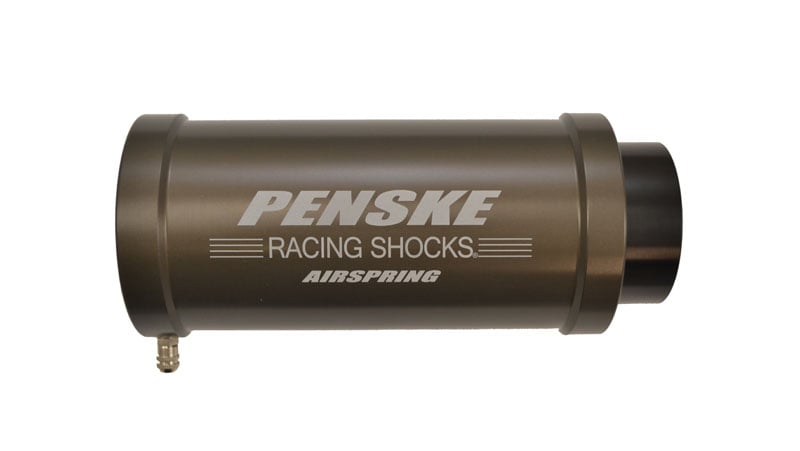 Air suspension has been around since the early 1900s and was used in World War II by the U.S. military for use on heavy trucks. Today, air springs are used in cars and SUVs and provide a whole new window of adjustability. While conventional springs require manually adding preload to increase the initial starting load, you can’t change the rate unless you have spring rubbers or other items that you have to install in between the coils manually. With air springs, you can increase the clearance between the vehicle and the ground and avoid road or trail hazards.
Air suspension has been around since the early 1900s and was used in World War II by the U.S. military for use on heavy trucks. Today, air springs are used in cars and SUVs and provide a whole new window of adjustability. While conventional springs require manually adding preload to increase the initial starting load, you can’t change the rate unless you have spring rubbers or other items that you have to install in between the coils manually. With air springs, you can increase the clearance between the vehicle and the ground and avoid road or trail hazards. You also probably recognize “Air Ride Equipped” on larger transporters or RVs. For these larger, heavier vehicles, air springs make it possible for passengers to avoid the heavy vibrations that may otherwise be felt during trips. The springs are easily adjustable with air lines that more or less air that will increase the load. Depending on the design, you can change the rate fairly easily.
While air springs may make the drive on a family RV camping trip or afternoon off-roading more enjoyable, for most vehicles, air springs also have their cons. Disadvantages to air springs include their reaction to heat, and they can change quite quickly when heat is added or taken away. This must be taken into consideration when setting up your suspension with any type of air support. Another disadvantage is the potential expense of air springs, as they are often more costly to maintain.
Air springs and air shocks have become very popular over the last decade. Mainly introduced and raced quite heavily in the off-road scene, air springs have found their way onto trucks, dirt bikes, mountain bikes, and yes, even F1 cars utilized air springs during this period. Currently if you're familiar with Dirt Late model racing, no doubt you have heard of air shocks and springs. They are commonly used today in this racing series.
Bump Rubbers
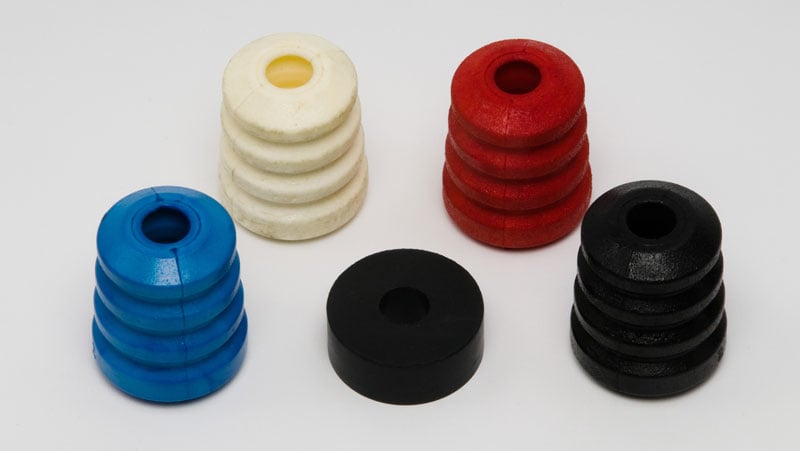 Bump rubbers have been around since we have been riding around on two or four wheels and have evolved over decades of development. Bump rubbers are typically round-shaped pieces of foam or rubber; the average is about two inches tall that is used as an anti-bottoming tuning tool. The bump rubber absorbs shock and provides extra cushion while protecting the vehicle, preventing contact between the tires and fender, for example. Over the years, especially in racing, these have become essential pieces to tuning a car or motorcycle suspension.
Bump rubbers have been around since we have been riding around on two or four wheels and have evolved over decades of development. Bump rubbers are typically round-shaped pieces of foam or rubber; the average is about two inches tall that is used as an anti-bottoming tuning tool. The bump rubber absorbs shock and provides extra cushion while protecting the vehicle, preventing contact between the tires and fender, for example. Over the years, especially in racing, these have become essential pieces to tuning a car or motorcycle suspension.
As discussed, coil springs produce a linear rate throughout their travel until they “coil bind” or run out of travel. At this point, your suspension would go completely solid. If you can imagine your suspension moving through travel, nice and compliant, then in an instant, solid/no movement, you can see how bad that would be for handling and feel.
Typically installed on the shock shaft, bump rubbers can also be installed on another part of the suspension that will engage before fully bottoming out. They are typically very stiff compared to the spring rate, and they are usually at a progressive rate. So, the first half inch of travel has less rate than the last half inch of travel. While bump stops are important for all vehicles, they are especially important to protect them from rough terrain and prolong the life of various suspension components. 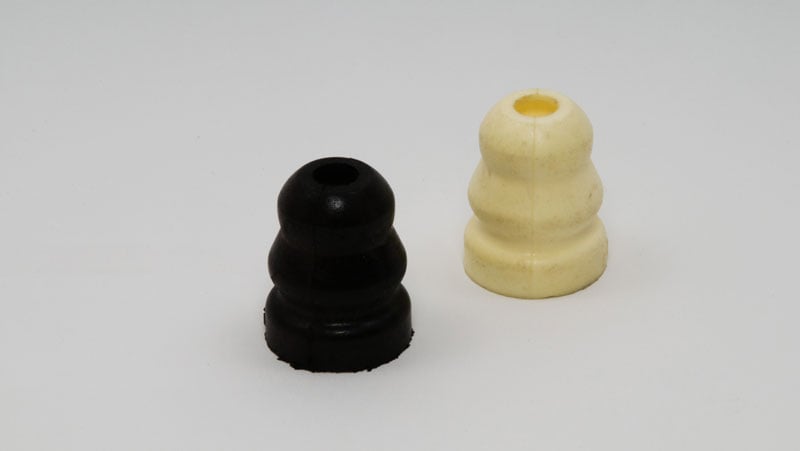
Damping: How It Can Help or Hurt Your Spring Rate
Shocks tame the oscillating effect of your springs as they store and release energy. As the primary function of shocks is to control how fast wheels go up and down, well-maintained shocks can give you the leverage to win a race or the ability to drive on varying terrains. However, as shocks are just a part of the suspension puzzle, having them in your vehicle doesn’t mean you’re going to necessarily have smooth sailing.
Drivers can experiment with different factors, such as their damping rate, to gain better control over their car. These adjustments can prevent oversteer or understeer, loss of traction, jarring movements, nose dives during braking, and more.
The different damping levels and curves include:
- Compression
- Rebound
- Linear Damping
- Progressive Damping
- Digressive Damping
- Regressive
In this section, we will cover different damping levels and explain how they relate to overall suspension, but more importantly, how they can assist in the performance of the spring.
Hungry for more?
- How to Read a Shock Dyno Graph to Gain a Setup Advantage
- 5 Risks of Not Doing a Shock Rebuild Before the Race Season
- Monotube vs. Twin Tube Shocks: Which is Best for Performance
- Are Your Double Adjustable Shocks Really "Double Adjustable"?
Compression Damping
Compression is when the suspension compresses. Therefore, your spring is compressing. This creates more load at a linear rate while traveling. Springs create force based on displacement or travel, and shocks produce more force based on velocity or the speed at which it’s moving. If you preload 250 lb spring two inches, you should produce 500 lbs of force sitting statically.
Now, if you take a shock and you do the same thing, the shock will produce no force statically regardless of its position. The shock will only produce more force if the speed of the movement is increased. This is the velocity and is usually measured in inches per second or millimeters per second. So, if you increase compression damping, it will slow or reduce the amount of compressed travel a suspension will travel. When done correctly, compression damping can help resolve common racing suspension issues, such as instability and rough rides.
Rebound
Compression and rebound both impact how well you can handle your vehicle. While compression helps control the suspension as it compresses, the rebound does the exact opposite. Remember, as a spring compresses, it creates more load or stores energy. That energy must be released, which is the rebound. If you had no rebound in the shocks, it would allow your suspension just to continue to bounce on the spring. You need to rebound from the shock to control and ultimately settle your suspension.
Generally, the stiffer the spring rate, the more rebound you will need to control the increase in force or energy the spring produces. Again, like compression, this sounds simple, but there are many factors and tuning options in the rebound that will help you enhance and maximize your suspension’s performance. With the right approach, you can improve your vehicle’s traction and feel more control and comfort behind the wheel.
Types of Damping Curves
Compression and rebound damping can assist with spring rate and ultimately work with your spring to define your suspension character. Now, we will preview a few different types of damping curves and how they can affect the performance of your suspension.
- Linear - Linear damping is the most common type of damping curve and has been around since shocks were developed. Simply put, the damping force gains at a linear rate, similar to what your spring does when it travels.
- Progressive - Progressive is pretty basic and does what it sounds like. As the speed of the shock or damper increases, the force it produces progressively gets stiffer. So the shock may have a 100 lb rate increase initially from 1” to 5”, but then have 150 or 175lb increasing rate from 5” to 10” velocity. These are just round arbitrary values, but you get the idea.
- Digressive - The opposite of progressive is digressive. Digressive means you have stiffer low-speed damping levels compared to your high-speed damping levels. So, imagine the slow-moving low-speed shock movement you produce at a rate of 100 lbs. Then you get to a point where you digress, and the shock only produces 50 lbs of the rate at higher velocity. This curve is very common in racing. This type of curve typically gives a rider or driver a more stable feel. The suspension may feel more predictable for the rider or driver, which is usually a good thing.
- Regressive - Lastly, we have regressive damping. This is a new form of damping technology developed specifically for curb strikes. Developed in the early 2000s for use in Formula One, this has become a very popular type of damping, utilized in all forms of motorsports and even mountain bikes. This form of damping is becoming very popular on all vehicles; it allows you to have a very stiff low-speed damping value, which aids in giving a very stable platform. Unlike digressive damping, where high-speed damping is less of an increase in damping, it still is stiffer than the low-speed force. The regressive valve actually allows you to have softer high-speed damping than low-speed, almost as if you have two shocks controlling the suspension at once.
Check out our ON-DEMAND WEBINAR: Top 10 Most Common Suspension Issues & How to Resolve Them
In this free webinar, we review the most common suspension issues you’re likely to encounter and tips for how you can resolve or avoid them altogether.
Configuring Your Shock Setup
Whether you’re looking to win races or just maintain the integrity of your vehicle, investing in your suspension is one of the best things you can do. But in addition to having the correct shocks and springs, it’s crucial to have them adjusted to the right settings for YOU. These settings can depend on a lot of factors, such as the vehicle, equipment, driving style, and environmental conditions. Additionally, key suspension components like shocks, for example, need to be serviced at least once a year, and this can increase based on similar factors as well.If you don’t know what the correct settings are or the types of shocks you should use, know that there are experts that can help you achieve the right configuration and get more out of your shock setup faster. At Penske Shocks, we’ll work with you to begin the setup optimization process before you purchase anything. To learn more about our S3 process (Shocks + Setup + Support), reach out to us here today.
